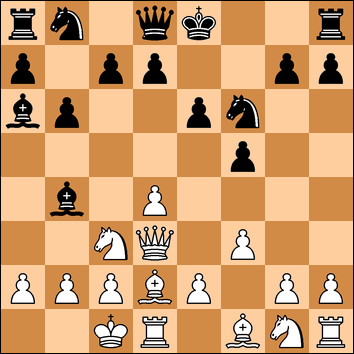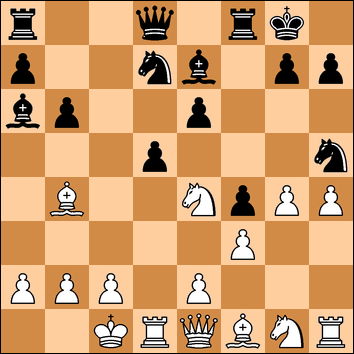Thursday 23 February 2017
White: T. Owen (170) - Black: K. Nevols (134)
Black against the club champion and a very strong player - who at the time was on 100%. I knew I had a tough battle here.
1. d4 f5
Time to wheel out the Dutch again.
2. Qd3!?
But what's this? In my study of the sidelines, I had not come across this move.
Apparently it is called the Manhattan variation. Obviously I have to defend the f-pawn but how? 2. .. d5 appears to be the most popular. But I decided to stick to the classical variation and, without knowing, chose the second most popular move.
2. .... e6
Part of the idea of the Dutch is to prevent the White move e4. So I now expected 3. e4 but after 3. .. fxe4 4. Qxe4 Nf6 or 4. ... Nc6, we are not doing too bad.
Playing the dangerous 3. g4 appears to be another option with 3. .. fxg4 4. h3 g3 5. Qxg3 Nf6 6. Nf3 and White is not looking too bad.
3. Nc3
White adopts a more peaceful plan of development and I reply in kind.
3. .... Bb4
4. Bd2 Nf6
5. f3
Looks like White wants to play e4. 5. a3 hitting the bishop might have been a more accurate move, although Black has the wonderful tactic 5. .. Nc6. (6. axb4? Nxb4 and 7. Nxc2+).
One of the principles of the Dutch is that, if White does not develop his bishop along the h1-a8 diagonal, then Black should try and do so. The next move also gives the future options of Ba6 and c5.
5. .... b6
Now 6. Qc4 or 6. e4 are recommend - instead White puts himself under pressure by reducing the number of squares available to the queen.
6. O-O-O!? Ba6

7. Qe3
White's development is a bit of a mess. The queen is getting in the way of everything. Having said that, there is no way yet for Black to take a serious advantage.
7. .... O-O
I knew my opponent was a dangerous attacking player and now think maybe I should have played 7. .. Nc6 with the aim to castle queenside. By castling kingside I was inviting the next move.
8. h4
They always say you should counter a wing attack with play in the centre.
8. ... c5
9. dxc5 Bxc5
White's queen continues to be short of squares - so I take the opportunity to keep kicking it.
10. Qg5 Be7
Maybe 10. .. d5 is better, staking a claim to the centre. If 11. h5 then 11. .. h6, or if 11. e3 Bxf1 12. Rxf1 Nc6. But I could not resist the opportunity to keep harassing the queen.
11. Qg3 Nh5
12. Qe1
Now Black should play 12. .. Qc7 keeping up the pressure.
12. ... f4
I was really enjoying the way that I was pushing White back but also cautious of over-reaching.
13. Ne4 d5
14. Bb4 Nd7
Developing the bishop and blocking the queen from the rook along the d-file.
15. g4

With this move, White offered me a draw. Had there been spectators, they would have been disappointed.
Now although my position was good, I could not see a clear way to improve it. While White has ideas if Bh3 and Ng5. After 15. .. fxg3 16. Bxe7 Qxe7 17. Nxg3 White had attacking chances against the e6 pawn. Or .. 15.... dxe4 16. gxh5 e3 17. Bh3 did not look much fun and the computer states one line could be 17. ... Bc4 18. b3 Bd5 19. c4 Bxb4 20. Qxb4 Qc7 21. Kb1 a5 - or even a queen sacrifice with 17. ... Rf6 18. Bc3 Rh6 19. Be5 Nxe5!? 20. Rxd8+ Rxd8.
The game looked horribly complicated - indeed we found all sorts of combinations and variations afterwards with White attacking down the d-file, against e6, etc - but the main thing to consider was that I was playing Black against a much stronger player and he was offering me a draw in a position with which I was not comfortable - so I accepted.
Agreed Draw
No comments:
Post a Comment